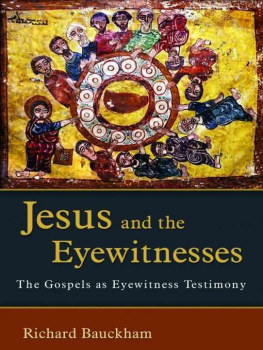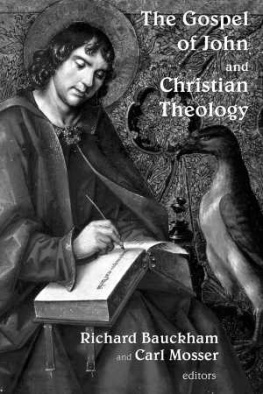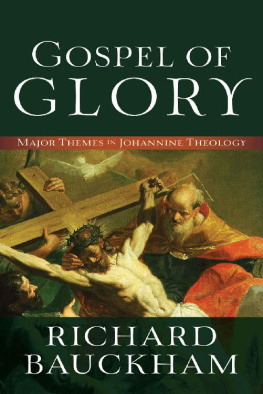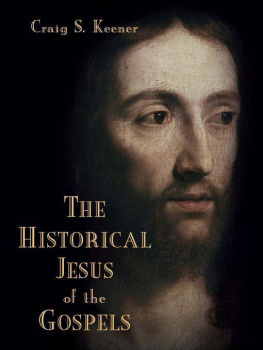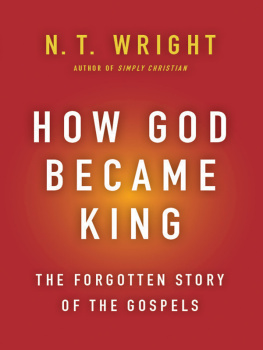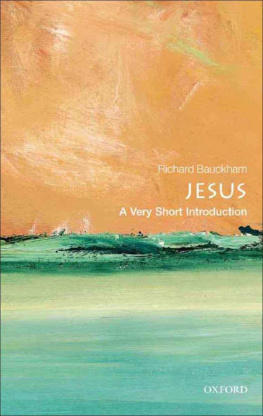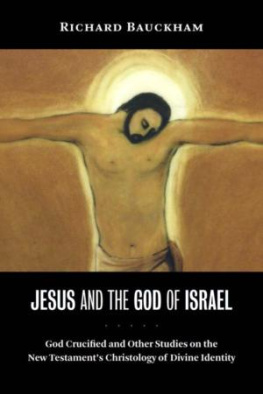Table of Contents
2006 Richard Bauckham
All rights reserved
Published 2006 by
Wm. B. Eerdmans Publishing Co.
2140 Oak Industrial Drive N.E., Grand Rapids, Michigan 49505 /
P.O. Box 163, Cambridge CB3 9PU U.K.
Printed in the United States of America
11 10 09 08 07 06 7 6 5 4 3 2 1
Library of Congress Cataloging-in-Publication Data
Bauckham, Richard.
Jesus and the eyewitnesses: the Gospels as eyewitness testimony / Richard Bauckham. p. cm.
ISBN-10: 0-8028-3162-1 / ISBN-13: 978-0-8028-3162-0 (cloth: alk. paper)
1. Jesus Christ Historicity. 2. Bible. N.T. Gospels Evidences, authority, etc. I. Title.
BT303.2.B36 2006 226.067 dc22
2006016806
www.eerdmans.com
To all my colleagues,
past and present,
in St Marys College,
University of St Andrews
Preface
Some of the material in this book was first presented as lectures that I was invited to give in three institutions in the U.S.: the fourteenth Annual Biblical Studies Lectures, 2003, at Beeson Divinity School, Samford University, Birmingham, Alabama; the Payton Lectures, 2003, at Fuller Theological Seminary, Pasadena, California; and the Derward W. Deere Lectures, 2004, at Golden Gate Baptist Theological Seminary, Mill Valley, California. I am grateful to these institutions for inviting me and to many people, staff and students, who made valuable comments on the lectures and who helped to make my visits a great pleasure.
Much of this book was written during a gradual recuperation from prolonged illness. I believe it could not have been written without the prayers of many who supported me during that period, or without to use Pauls phrase (2 Cor 12:9) Gods grace working as power in weakness.
RICHARD BAUCKHAM
Abbreviations
From the Historical Jesus to the Jesus of Testimony
The Historical Quest and Christian Faith
For two centuries scholars have been in quest of the historical Jesus. The quest began with the beginnings of modern historical critical study of the New Testament. It has often seemed the most significant task that critical study of the New Testament could pursue. Thousands of scholars have been drawn into the pursuit, and hundreds, perhaps thousands, of books, scholarly and popular, have been products of the quest. Interest and activity have waxed and waned over the years. Many have pronounced the quest misguided, fruitless, and finished. Others have castigated their predecessors but put their faith in new methods and approaches that they claim will succeed where others failed. Whole eras of western cultural, as well as religious, history have been reflected in the various stages of the quest. Attitudes to the quest, positive, negative, or qualified, have distinguished whole schools of theology.
At the beginning of the twenty-first century the quest of the historical Jesus flourishes as never before, especially in North America. The unprecedented size of the industry of New Testament scholarship and the character of the American media both play a part in this. But the fact that the figure of Jesus retains its supremely iconic significance in American culture, as compared with the more secularized societies of Europe and the British isles, is what makes the continuing efforts of historians rather than theologians or spiritual leaders to reconstruct the historical reality of Jesus a matter of seemingly endless interest to believers, half-believers, ex-believers, and would-be believers in the Jesus of Christian faith. Is the so-called historical Jesus the Jesus historians may reconstruct as they do any other part of history the same Jesus as the figure at the center of the Christian religion? This is the question that both excites and disturbs the scholars and the readers of their books alike.
From the beginning of the quest the whole enterprise of attempting to reconstruct the historical figure of Jesus in a way that is allegedly purely historical, free of the concerns of faith and dogma, has been highly problematic for Christian faith and theology. What, after all, does the phrase the historical Jesus mean? It is a seriously ambiguous phrase, with at least three meanings. It could mean Jesus as he really was in his earthly life, in that sense distinguishing the earthly Jesus from the Jesus who, according to Christian faith, now lives and reigns exalted in heaven and will come to bring history to its end. In that sense the historical Jesus is by no means all of the Jesus Christians know and worship, but as a usage that distinguishes Jesus in his earthly life from the exalted Christ the phrase could be unproblematic.
However, the full reality of Jesus as he historically was is not, of course, accessible to us. The world itself could not contain the books that would be needed to record even all that was empirically observable about Jesus, as the closing verse of the Gospel of John puts it. Like any other part of history, the Jesus who lived in first-century Palestine is knowable only through the evidence that has survived. We could therefore use the phrase the historical Jesus to mean, not all that Jesus was, but Jesus insofar as his historical reality is accessible to us. But here we reach the crucial methodological problem. For Christian faith this Jesus, the earthly Jesus as we can know him, is the Jesus of the canonical Gospels, Jesus as Matthew, Mark, Luke, and John recount and portray him. There are difficulties, of course, in the fact that these four accounts of Jesus differ, but there is no doubt that the Jesus of the churchs faith through the centuries has been a Jesus found in these Gospels. That means that Christian faith has trusted these texts. Christian faith has trusted that in these texts we encounter the real Jesus, and it is hard to see how Christian faith and theology can work with a radically distrusting attitude to the Gospels.
Yet everything changes when historians suspect that these texts may be hiding the real Jesus from us, at best because they give us the historical Jesus filtered through the spectacles of early Christian faith, at worst because much of what they tell us is a Jesus constructed by the needs and interests of various groups in the early church. Then that phrase the historical Jesus comes to mean, not the Jesus of the Gospels, but the allegedly real Jesus behind the Gospels, the Jesus the historian must reconstruct by subjecting the Gospels to ruthlessly objective (so it is claimed) scrutiny. It is essential to realize that this is not just treating the Gospels as historical evidence. It is the application of a methodological skepticism that must test every aspect of the evidence so that what the historian establishes is not believable because the Gospels tell us it is, but because the historian has independently verified it. The result of such work is inevitably not one historical Jesus, but many. Among current historical Jesuses on offer there is the Jesus of Dominic Crossan, the Jesus of Marcus Borg, the Jesus of N. T. (Tom) Wright, the Jesus of Dale Allison, the Jesus of Gerd Theissen, and many others. The historians judgment of the historical value of the Gospels may be minimal, as in some of these cases, or maximal, as in others, but in all cases the result is a Jesus reconstructed by the historian, a Jesus attained by the attempt to go back behind the Gospels and, in effect, to provide an alternative to the Gospels constructions of Jesus.





